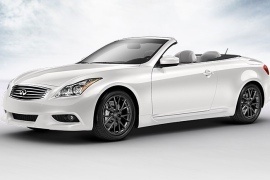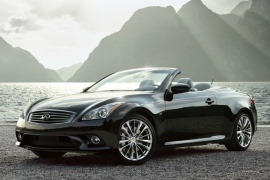
INFINITI Q60 Convertible
Generations Timeline, Specs and Pictures

Part of a brand-wide renaming strategy, the G47 Convertible received the Q60 Convertible name, still remaining a relatively unchanged value driven machine.
Stylistic changes are minimal and so does the ones underneath. However, the chassis has been slightly retuned to offer balance between refined ride quality and precise dynamics. With supple leather appointments and Silk Obi aluminum accents, the elegant interior of the Q60 Convertible is designed to captivate and provide a refined atmosphere, whether the top is up or down. The available Bose® Open Air System monitors ambient noise, vehicle speed and hardtop position. Then it dynamically adjusts the amplifier’s equalization to create unrivaled clarity across all 13 speakers, whether the top is up or down. Meanwhile, AudioPilot® 2.0 noise compensation technology helps reduce unwanted outside noise to preserve optimum listening conditions. The exclusive IPL-tuned engine and suspension augment the driving experience while aggressive styling and aerodynamics visually express the elemental strength contained within.

Nissan’s premium brand, Infiniti, moved to the market of luxury convertibles with the Q60.
It featured a complicated retractable hard-top that could fit into the trunk and leave its occupants in the open air. It was an evolution of the Q6 Coupe with nice finishes and touches.
The platform was adapted from the Nissan 370Z and was longer by 50 cm (19.6”), which should lead to decent legroom for the rear passengers. That said, the rear seats were only big enough to accommodate shorter passengers. The dashboard was plain and simple, with big dials on the instrument cluster for the tachometer and speedometer.
The infotainment system had a screen on top of the dashboard and was controlled via buttons placed underneath it. It wasn’t the most high-tech, but it worked well even though tt was still based on the Nissan Primera’s infotainment system. The sound system was developed by Bose and had a noise cancellation system.
The 7-speed automatic gearbox was fitted as an option while the 6-speed manual was offered as standard. An interesting feature for a car that was intended to be a relaxed cruiser was the rear limited-slip differential. Since the car weighed over 1900 kg (4188 lbs) with the automatic gearbox, the performance was not great. Also, the fuel consumption was high, with a declared average value of 12.4 l/100 km (18.5 mpg-US).























































